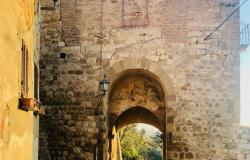Parading figures outfitted in caps with half-metre tall plums and padded doublets with canary yellow and garnet red stripes twirl and throw flags bearing medieval neighbourhood standards with an elegant flourish. Their companions, marching along in a jaunty though slightly disorganised formation, toot regal tunes on their trumpets as if announcing the arrival of a king or a duke.
The palio is about to begin!
Every summer, cities, towns, and small mountain villages around Italy maintain the medieval tradition of the palio, an event named not for a specific type of race or parade, but the prize they all have in common. A palio, from the Latin word for cloak pallium is a standard-like flag, made from rich fabric covered with intricate stitching that the winner of the palio race gains the honour of keeping in their neighbourhood church for a year following their victory.
Though the most famous palio, the Palio of Siena, revolves around a horse race, Italian palios take many forms: foot races, donkey races, boat races, archery matches, and more. In addition to the main competition, each palio includes parades, music, flag throwing, and neighbourhood celebrations.
Here is our guide to the most unique and well-known summer palios around the country:
MAY
Seravezza
In a small town outside Lucca, one of the most unique palio races takes place each year in early May. The Palio dei Micci is not a race or horses, dogs, or even men, but donkeys. Part of the Contrada La Quercia, a full weekend of parading and medieval faire activities, the donkey race between Seravezza’s eight districts is one of the most important historic events in the Province of Lucca.

Ferrara
Dating back to 1259, the Palio di Ferrara is one of the oldest known palios, with written statues from 1287 setting the date for the two annual palios, one on the 23rd of April to honour the city’s patron saint, St. George, and one on Ferragosto in honour of the Virgin Mary. Today, the official infant, donkey, and horse races of the massive palio take place on the last Sunday in May, honouring the day in 1471 when Borso d’Este returned from Ferrara bearing the new title Duke of Ferrara. Medieval parades and performances begin in March and run every weekend leading up to the event.
JUNE
Castiglion Fiorentino
If you are not in town for the Palio di Siena, or simply started planning too late to find a place to stay, the Palio dei Rioni in Castiglion Fiorentino-Arezzo is an ideal substitute with a pace and scale that allows visitors to get much closer to the action. The horse and rider blessings, horse race, flag competition, and medieval parade all take place in one day, so visitors can easily catch all the palio events in a day trip. Each of the city’s three historic rioni—Porta Cassero, Porta Fiorentina, and Porta Romana—also host a vigil dinner on the eve of the palio to invoke victory.
Fossano
Fossano’s Giostra de l’Ora/Palio dei Borghi began in 1585 as a celebration for Duke Carlo Emanuele I of Savoia on the occasion of his return from Spain with his new wife Catherine of Hapsburg. Though the Fossanese palio has abandoned the cruel practice from which it takes its name—enclosing the bodies of geese in cages so competitors on horseback can race by and slash off their sticking-out heads with a sword—citizens of the seven city quarters still parade in splendidly rich medieval costumes and show off their riding skills as they did in the 16th century to honour the passing royalty. The palio typically takes place the last weekend in June.

JULY
Lucca
Lucca’s Palio della Balestra di San Paolino offers yet another take on the palio tradition: archery. Participants take one shot with a crossbow from a distance of 36 metres. The event takes place in mid-June, though the exact date changes each year, but it always ends with a spectacular fireworks display on the night of the competition. The city’s first crossbow Palio took place in the 14th century, and the first recorded rules—dating back to June 1443—are still stored in the city archives.
Siena
Italy’s most famous palio, the Palio di Siena steals the thunder of palios around the country with its high-profile celebrations, high-stakes gambling, and highly publicized spectacle. Siena’s palio actually takes place in two parts, with the city’s historic contrade (neighborhoods) choosing lots to see who will compete in the first race on July 2. Though many visitors come for the heart-stoppingly intense, one-minute horse race that is the palio’s main event, the pre- and post-parties in the contrade are actually the highlight of the palio season. Try to get yourself invited to the winning contrada’s after-party, where the prized horse is brought to the local church and locals throw coins at it for luck.

AUGUST
La Spezia
The Palio del Golfo della Spezia is rare among Italian palios in that it takes place on water not land. Each year, thirteen specially designed, extra-agile ships—one from each of the thirteen city quarters that run along the gulf—participate in a sea parade on Friday, demonstrations of traditional sea occupations Saturday, and a race on the first Sunday of August. Its origins stem not only from displays of neighbourhood pride, but also from economic advantage: the winner of the palio was entitled to priority passage through the gulf and offloading of fish at the docks.
Siena
The second edition of the Palio di Siena, including the seven Contrade who did not run in the previous year's August Palio plus a further 3 drawn by lot, takes place on August 16.













